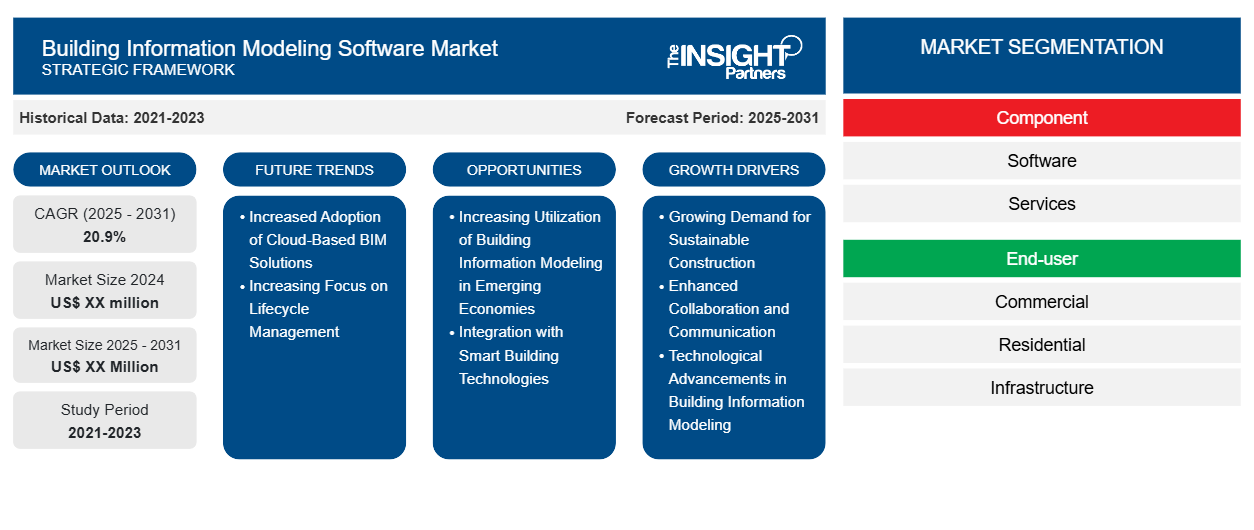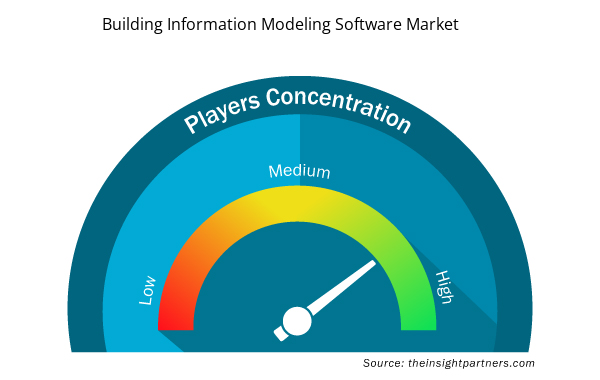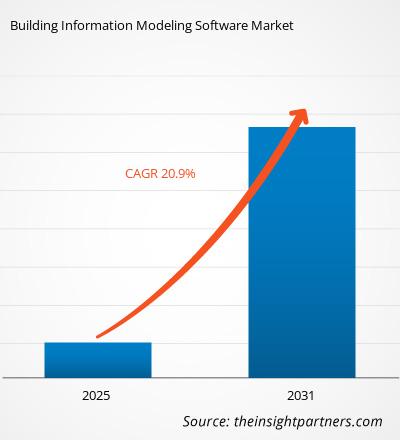The Building Information Modeling Market is expected to register a CAGR of 20.9% from 2025 to 2031, with a market size expanding from US$ XX million in 2024 to US$ XX Million by 2031.
The report is segmented by Component (Software, Services); End-user (Commercial, Residential, Infrastructure, Industrial). The global analysis is further broken-down at regional level and major countries. The report offers the value in USD for the above analysis and segments
Purpose of the Report
The report Building Information Modeling Market by The Insight Partners aims to describe the present landscape and future growth, top driving factors, challenges, and opportunities. This will provide insights to various business stakeholders, such as:
- Technology Providers/Manufacturers: To understand the evolving market dynamics and know the potential growth opportunities, enabling them to make informed strategic decisions.
- Investors: To conduct a comprehensive trend analysis regarding the market growth rate, market financial projections, and opportunities that exist across the value chain.
- Regulatory bodies: To regulate policies and police activities in the market with the aim of minimizing abuse, preserving investor trust and confidence, and upholding the integrity and stability of the market.
Building Information Modeling Market Segmentation
Component
- Software
- Services
End-user
- Commercial
- Residential
- Infrastructure
- Industrial
Customize This Report To Suit Your Requirement
You will get customization on any report - free of charge - including parts of this report, or country-level analysis, Excel Data pack, as well as avail great offers and discounts for start-ups & universities
Building Information Modeling Software Market: Strategic Insights

- Get Top Key Market Trends of this report.This FREE sample will include data analysis, ranging from market trends to estimates and forecasts.
Building Information Modeling Market Growth Drivers
- Growing Demand for Sustainable Construction: The increasing emphasis on sustainable construction practices is a significant driver for the Building Information Modeling (BIM) market. As stakeholders seek to minimize environmental impacts, BIM provides essential tools for optimizing energy efficiency, reducing waste, and improving resource management throughout a building's lifecycle. By facilitating better decision-making during the design phase, BIM enables architects and engineers to create more sustainable structures. This alignment with global sustainability goals is propelling the adoption of BIM technologies, as organizations strive to meet regulatory requirements and consumer expectations for eco-friendly buildings.
- Enhanced Collaboration and Communication: The need for improved collaboration among project stakeholders is driving the growth of the BIM market. BIM enables seamless communication between architects, engineers, contractors, and clients by providing a shared digital model of the project. This collaborative approach reduces misunderstandings, minimizes errors, and accelerates project timelines. By fostering teamwork and facilitating real-time updates, BIM helps ensure that all parties are aligned throughout the construction process. As the construction industry recognizes the importance of collaboration, the demand for BIM solutions continues to rise.
- Technological Advancements in Building Information Modeling: Rapid advancements in technology, particularly in software capabilities and hardware performance, are significantly influencing the BIM market. Innovations such as cloud computing, artificial intelligence (AI), and virtual reality (VR) are enhancing BIM tools by providing more powerful modeling, analysis, and visualization capabilities. These technologies enable users to simulate complex scenarios, analyze project performance, and make informed decisions early in the design process. As these technological developments continue to evolve, they will drive further adoption of BIM solutions across the construction industry.
Building Information Modeling Market Future Trends
- Increased Adoption of Cloud-Based BIM Solutions: A prominent trend in the Building Information Modeling market is the rising adoption of cloud-based BIM solutions. Cloud technology allows for enhanced accessibility, scalability, and collaboration among project teams, regardless of location. This shift enables stakeholders to work on a common digital platform, streamlining workflows and reducing project delays. As remote work becomes more common and organizations seek efficient collaboration tools, the demand for cloud-based BIM solutions is expected to grow, making it a key trend within the market.
- Increasing Focus on Lifecycle Management: Another significant trend in the BIM market is the growing focus on lifecycle management. As organizations recognize the importance of managing a building throughout its entire lifecycle—from design and construction to operation and maintenance—BIM is becoming an essential tool for optimizing performance at every stage. By incorporating lifecycle management principles into BIM processes, stakeholders can analyze long-term impacts, identify maintenance needs, and enhance overall building performance. This trend underscores the evolving role of BIM as a comprehensive solution for managing not just the design phase, but the entire lifecycle of a building.
Building Information Modeling Market Opportunities
- Increasing Utilization of Building Information Modeling in Emerging Economies: The Building Information Modeling market has substantial growth opportunities in emerging markets, where rapid urbanization and infrastructure development are taking place. Countries in regions such as Asia-Pacific, Latin America, and Africa are increasingly investing in construction projects, creating a demand for advanced planning and design tools. BIM can help these markets achieve efficient project execution, cost savings, and improved sustainability. By offering tailored BIM solutions that address local challenges, software providers can capitalize on this growing opportunity.
?
- Integration with Smart Building Technologies: The integration of BIM with smart building technologies presents significant opportunities for market growth. As the Internet of Things (IoT) becomes more prevalent in construction, combining BIM with IoT data can enhance building management and operational efficiency. For example, real-time data can inform maintenance schedules, energy consumption, and occupancy patterns, leading to better decision-making throughout the building’s lifecycle. By developing integrated solutions that leverage both BIM and smart building technologies, companies can position themselves at the forefront of this emerging trend.
Building Information Modeling Software Market Regional Insights
The regional trends and factors influencing the Building Information Modeling Software Market throughout the forecast period have been thoroughly explained by the analysts at Insight Partners. This section also discusses Building Information Modeling Software Market segments and geography across North America, Europe, Asia Pacific, Middle East and Africa, and South and Central America.

- Get the Regional Specific Data for Building Information Modeling Software Market
Building Information Modeling Software Market Report Scope
| Report Attribute | Details |
|---|---|
| Market size in 2024 | US$ XX million |
| Market Size by 2031 | US$ XX Million |
| Global CAGR (2025 - 2031) | 20.9% |
| Historical Data | 2021-2023 |
| Forecast period | 2025-2031 |
| Segments Covered |
By Component
|
| Regions and Countries Covered | North America
|
| Market leaders and key company profiles |
Building Information Modeling Software Market Players Density: Understanding Its Impact on Business Dynamics
The Building Information Modeling Software Market market is growing rapidly, driven by increasing end-user demand due to factors such as evolving consumer preferences, technological advancements, and greater awareness of the product's benefits. As demand rises, businesses are expanding their offerings, innovating to meet consumer needs, and capitalizing on emerging trends, which further fuels market growth.
Market players density refers to the distribution of firms or companies operating within a particular market or industry. It indicates how many competitors (market players) are present in a given market space relative to its size or total market value.
Major Companies operating in the Building Information Modeling Software Market are:
- AECOM
- Autodesk, Inc.
- Beck Technology, Ltd.
- Bentley Systems, Inc.
- Dassault Systemes SA
Disclaimer: The companies listed above are not ranked in any particular order.

- Get the Building Information Modeling Software Market top key players overview
Key Selling Points
- Comprehensive Coverage: The report comprehensively covers the analysis of products, services, types, and end users of the Building Information Modeling Market, providing a holistic landscape.
- Expert Analysis: The report is compiled based on the in-depth understanding of industry experts and analysts.
- Up-to-date Information: The report assures business relevance due to its coverage of recent information and data trends.
- Customization Options: This report can be customized to cater to specific client requirements and suit the business strategies aptly.
The research report on the Building Information Modeling Market can, therefore, help spearhead the trail of decoding and understanding the industry scenario and growth prospects. Although there can be a few valid concerns, the overall benefits of this report tend to outweigh the disadvantages.
- Historical Analysis (2 Years), Base Year, Forecast (7 Years) with CAGR
- PEST and SWOT Analysis
- Market Size Value / Volume - Global, Regional, Country
- Industry and Competitive Landscape
- Excel Dataset



Report Coverage
Revenue forecast, Company Analysis, Industry landscape, Growth factors, and Trends

Segment Covered
This text is related
to segments covered.

Regional Scope
North America, Europe, Asia Pacific, Middle East & Africa, South & Central America

Country Scope
This text is related
to country scope.
Frequently Asked Questions
Some of the customization options available based on the request are an additional 3-5 company profiles and country-specific analysis of 3-5 countries of your choice. Customizations are to be requested/discussed before making final order confirmation# as our team would review the same and check the feasibility
The report can be delivered in PDF/PPT format; we can also share excel dataset based on the request
Cloud-based BIM solutions to play a significant role in the global building information modeling market in the coming years
Increased demand for efficient construction and compliance with rules and regulations are the major factors driving the building information modeling market
The Building Information Modeling Market is estimated to witness a CAGR of 20.9% from 2023 to 2031
Trends and growth analysis reports related to Technology, Media and Telecommunications : READ MORE..
1. AECOM
2. Autodesk, Inc.
3. Beck Technology, Ltd.
4. Bentley Systems, Inc.
5. Dassault Systemes SA
6. HEXAGON
7. Nemetschek AG
8. Pentagon Solutions Ltd.
9. Synchro Software Ltd.
10. Trimble Navigation Ltd.

 Get Free Sample For
Get Free Sample For